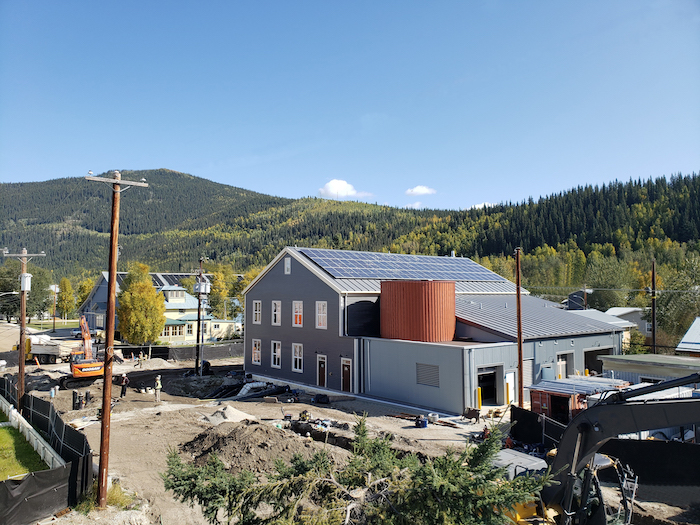
2020 #CCEawards Showcase: Dawson City Water Treatment Plant
November 24, 2020
By CCE
“The plant was completed with lots of care and good engineering techniques.” – Jury
Category: Water Resources
Award of Excellence Winner: Associated Engineering
Dawson City’s new water treatment plant is a model for efficiency, using renewable energy for heating and power. As the largest facility in Western Canada with cartridge filtration, it provides robust treatment for a community of 1,400 that typically swells to more than 5,000 during the summer. And the facility’s landmark architecture reflects the town’s character and history.
Opportunities for improvement
When the town’s 40-year-old drinking water treatment plant was struggling to meet Guidelines for Canadian Drinking Water Quality, the Yukon Government sought to replace the aging facility. The new facility needed to treat water drawn from four wells near the confluence of the Yukon and Klondike Rivers, where groundwater supply is at risk to contamination.
The government retained Associated Engineering to provide design and construction services for a new water treatment plant. After evaluating various processes, the design team recommended cartridge filtration as appropriate for the groundwater source, which is low in turbidity and colour.
The technology is simple to operate and eliminates the need for chemicals typically used in traditional water treatment systems. Since they are washable and reusable, the cartridges only need to be replaced about twice a year, a significant benefit given Dawson City’s remote location and limited access to supplies.
To treat 6 million L per day, the plant’s two-stage cartridge system uses 5-micron filters, along with a 1-micron filter to protect against protozoa pathogens. The treatment process also includes ultraviolet (UV) and chlorine gas disinfection.
Cold-climate engineering was essential to ensure water would not freeze pipes during winters when temperatures can drop below -40 C. Heat is drawn from a local wood chip biomass plant to supplement traditional oil-fired boilers. Exterior piping is insulated and heat-traced. During commissioning, water was constantly circulated through the underground pipes and adjacent reservoir to avoid freezing.
In the summer, the building’s power supply is augmented by a solar photovoltaic (PV) system.
Through a unique arrangement of piping and valves, the town’s fire pump supply flows are looped within the potable water distribution system. During the winter months, the potable water supply is pumped unidirectionally into the distribution system and water is directed back into the treatment plant for reheating to prevent freezing. This system ensures water remains in constant motion throughout the winter, while allowing fire flow supply to back-feed into the looped system when required.
Flood protection
Situated on the confluence of the Yukon and Klondike Rivers, Dawson City has been subject to large-scale flooding in the past. As an essential service, the plant needs to be protected.
Analysis of river levels in future climate-change scenarios showed flood levels exceeded the building’s ground elevation. Thus, the building’s foundation and walls were designed to resist a 200-year flood and all sensitive electrical equipment and controls were installed on the second floor.
Localized construction
The plant fits on a small footprint of two standard residential lots, which the team maximized by designing a two-storey structure and minimizing setbacks, working in consultation with Dawson City Council to obtain a special bylaw exemption. And given the limited setbacks for adjacent buildings, fire-rated wall materials were used and a fire suppression system was installed.
To reflect Dawson City’s history, including the Klondike Gold Rush, the team consulted with the town’s heritage advisory committee during design. The result is a façade that mimics the Pacific Cold Storage Building, an early 1900s structure, including a circular staircase leading from the front entrance to the second floor to replicate the circular tank that formed part of the original building.
Building materials included wood frames and dowel laminated timber (DLT) roof panels, sourced locally where possible to reduce transportation costs, minimize the project’s carbon footprint and expedite construction. The DLT roof also offers sound absorption, reducing exterior noise from the plant operations.
The $15-million plant was completed under budget and ahead of the Yukon Government’s schedule. Planning and design began in 2016, construction in 2018 and commissioning in 2019—and by the end of that year, residents were drinking water from the largest municipal cartridge filtration system in Western Canada.
Award-winning firm (lead consultant): Associated Engineering, Edmonton (Steven Bartsch, P.Eng.; Matt Lozie, P.Eng.; Richard Annett, C.Eng, P.Eng.; Louis De Lange, P.Eng.; Jared Suwala, P.Eng.).
Owner: Yukon Government.
Other key players: Kobayashi + Zedda Architects, Tetra Tech (geotechnical), Wildstone Construction Group (contractor).

